
Kamnaskires IV was the Kamnaskirid king of Elymais from 62/1 BC (or 59/8) to 56/5 BC. [1] [2]

Kamnaskires IV was the Kamnaskirid king of Elymais from 62/1 BC (or 59/8) to 56/5 BC. [1] [2]
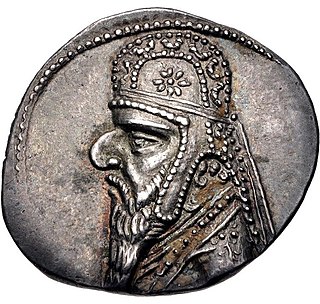
Mithridates II was king of the Parthian Empire from 124 to 91 BC. Considered one of the greatest of his dynasty to ever rule, he was known as Mithridates the Great in antiquity.

Mithridates I, also known as Mithridates I the Great, was king of the Parthian Empire from 165 BC to 132 BC. During his reign, Parthia was transformed from a small kingdom into a major political power in the Ancient East as a result of his conquests. He first conquered Aria, Margiana and western Bactria from the Greco-Bactrians sometime in 163–155 BC, and then waged war with the Seleucid Empire, conquering Media and Atropatene in 148/7 BC. In 141 BC, he conquered Babylonia and held an official investiture ceremony in Seleucia. The kingdoms of Elymais and Characene shortly afterwards became Parthian vassals. In c. 140 BC, while Mithridates was fighting the nomadic Saka in the east, the Seleucid king Demetrius II Nicator attempted to regain the lost territories; initially successful, he was defeated and captured in 138 BC, and shortly afterwards sent to one of Mithridates I's palaces in Hyrcania. Mithridates I then punished Elymais for aiding Demetrius, and made Persis a Parthian vassal.
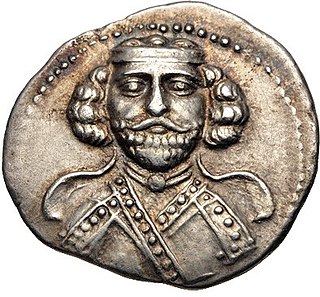
Phraates III, was King of Kings of the Parthian Empire from 69 BC to 57 BC. He was the son and successor of Sinatruces.

Phraates II was king of the Parthian Empire from 132 BC to 127 BC. He was the son and successor of Mithridates I.

Orodes II, was King of Kings of the Parthian Empire from 57 BC to 37 BC. He was a son of Phraates III, whom he murdered in 57 BC, assisted by his elder brother Mithridates IV. The two brothers quickly fell out and entered into a dynastic struggle, in which Orodes was triumphant.

Mithridates IV was a Parthian king from to 57 to 54 BC. He was the son and successor of Phraates III. Mithridates IV's reign was marked by a dynastic struggle with his younger brother, Orodes II, who eventually emerged victorious and had Mithridates IV executed, thus succeeding him.

Sinatruces was king of the Parthian Empire from c. 75 BC to c. 69 BC. He was presumably a son of the Parthian ruler Mithridates I. Sinatruces was succeeded by his son Phraates III.

Artabanus I, incorrectly known in older scholarship as Artabanus II, was king of the Parthian Empire, ruling briefly from c. 127 to 124/3 BC. His short reign ended abruptly when he died during a battle against the Yuezhi in the east. He was succeeded by his son Mithridates II.

Osroes I was a Parthian contender, who ruled the western portion of the Parthian Empire from 109 to 129, with a one-year interruption. For most of his reign he contended with the rival king Vologases III who was based in the eastern provinces. In 116, Osroes I was briefly ousted from his throne at Ctesiphon during an invasion by Roman emperor Trajan, who installed Osroes' son, Parthamaspates. After Trajan's death the following year, Osroes I's rule was reinstated by the Parthian nobility. In 129, he was removed from power by Vologases III.

Gotarzes I was king of the Parthian Empire from 91 BC to 87 or 80 BC. He was the son and successor of Mithridates II, and was succeeded by his son Orodes I.

Elymais or Elamais was an autonomous state of the 2nd century BC to the early 3rd century AD, frequently a vassal under Parthian control. It was located at the head of the Persian Gulf in Susiana. Most of the population probably descended from the ancient Elamites, who once had control of that area.
The Battle of Ecbatana was fought in 129 BC between the Seleucids led by Antiochus VII Sidetes and the Parthians led by Phraates II, and marked the final attempt on the part of the Seleucids to regain their power in the east against the Parthians. After their defeat, the territory of the Seleucids was limited to the area of Syria.
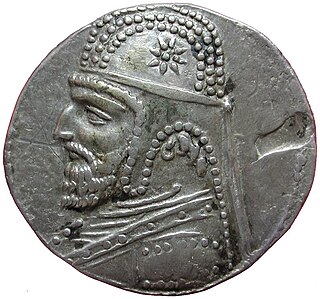
Orodes I, was king of the Parthian Empire from 80 to 75 BC. He was the son and heir of Gotarzes I. His reign is relatively obscure. His throne may have been usurped in 87–80 BC by his supposed uncle Mithridates III, however, this has found little support in scholarship. Of his military activities, it is known that Orodes I re-established Parthian rule in Elymais in 78 BC, which had been independent since 81/80 BC. Orodes I later lost the throne to the aged Parthian prince Sinatruces, who belonged to a different branch of the royal Arsacid family.
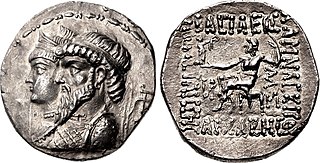
Kamnaskires III was the Kamnaskirid king of Elymais from 82/1 BC to 75 BC. Elymais had since 124 BC been under complete Parthian control. However, in 81/80 BC, coins of king Kamnaskires III and his wife Anzaze appears, which indicates that the kingdom had been restored. According to Babylonian sources, the incumbent Parthian monarch Orodes I launched an expedition into Elymais in 78 BC, where he defeated Kamnaskires III. Kamnaskires III was not deposed, however, and continued ruling the kingdom now as a Parthian vassal. Kamnaskires III's successor is unknown, however, it is known that Kamnaskires IV ruled Elymais from 62/1 BCE.
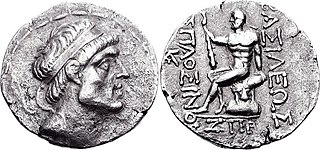
Hyspaosines was an Iranian prince, and the founder of Characene, a kingdom situated in southern Mesopotamia. He was originally a Seleucid satrap installed by king Antiochus IV Epiphanes, but declared independence in 141 BC after the collapse and subsequent transfer of Seleucid authority in Iran and Babylonia to the Parthians. Hyspaosines briefly occupied the Parthian city of Babylon in 127 BC, where he is recorded in records as king (šarru). In 124 BC, however, he was forced to acknowledge Parthian suzerainty. He died in the same year, and was succeeded by his juvenile son Apodakos.

Kamnaskires II, surnamed Nikephoros was a king of the Elymais only known from his coins. He reigned from about 147 to 139 BC. Around 150 BC, the Seleucid empire disintegrated and at several places local governors became independent and assumed the title of "king" (basileus). The first king in the Elymais was Kamnaskires Soter, who ruled around 147 BC. Kamnaskires II Nikephoros ruled slightly later and it is possible that he was identical with Kamnaskires Soter, just changing his name. In 140 BC, Kamnaskires II accepted Parthian suzerainty. However, not long after, Kamnaskires II aided the Seleucid ruler Demetrius II Nicator against the Parthian monarch Mithridates I. However, Demetrius was eventually defeated and captured by the Parthians. Mithridates I then punished Elymais for aiding the Seleucids–he invaded the region once more and captured two of their major cities.

Shapur was an Iranian prince, who was the penultimate King of Persis from 207–210 to 211/2. He was succeeded by his younger brother Ardashir I, who founded the Sasanian Empire.
Sagdodonacus was an Iranian officer, who served as the governor of Characene from c. 184 BC to 164 BC under suzerainty of the Frataraka rulers of Persis. He was the father of Hyspaosines.

Mithridates III was king of the Parthian Empire from 87 to 80 BC. His existence is disputed in scholarship.